How Does a Bread Box Work
A bread box works by creating an ideal environment for storing bread, balancing humidity and air circulation. It traps just enough moisture to prevent your bread from drying out while allowing excess to escape, which helps extend shelf life by 2-3 days compared to plastic storage. The box's design, typically featuring ventilation holes or slats, guarantees proper airflow to prevent mold growth. Materials like wood, metal, or plastic each affect moisture regulation differently. To use a bread box effectively, you'll need to remove plastic packaging, verify bread is cooled before storage, and clean it regularly. Understanding the mechanics behind bread boxes can help you maximize their benefits for keeping your bread fresh.
This post may contain affiliate links. If you make a purchase through these links, I may earn a commission at no additional cost to you. Additionally, portions of this post may be generated using artificial intelligence (AI) technology. While we strive for accuracy, please be aware that AI-generated content may not always be perfect and should be fact-checked when necessary.
The Spatula Scoops
- Bread boxes create an optimal environment by balancing humidity and air circulation to maintain bread freshness.
- They trap enough moisture to prevent bread from drying out while allowing excess to escape, preventing mold growth.
- Ventilation features like holes or slats ensure controlled air circulation within the bread box.
- The material of the bread box (wood, metal, or plastic) affects its ability to regulate moisture and airflow.
- Bread boxes extend bread shelf life by 2-3 days compared to plastic storage methods.
The Mechanics of Bread Boxes
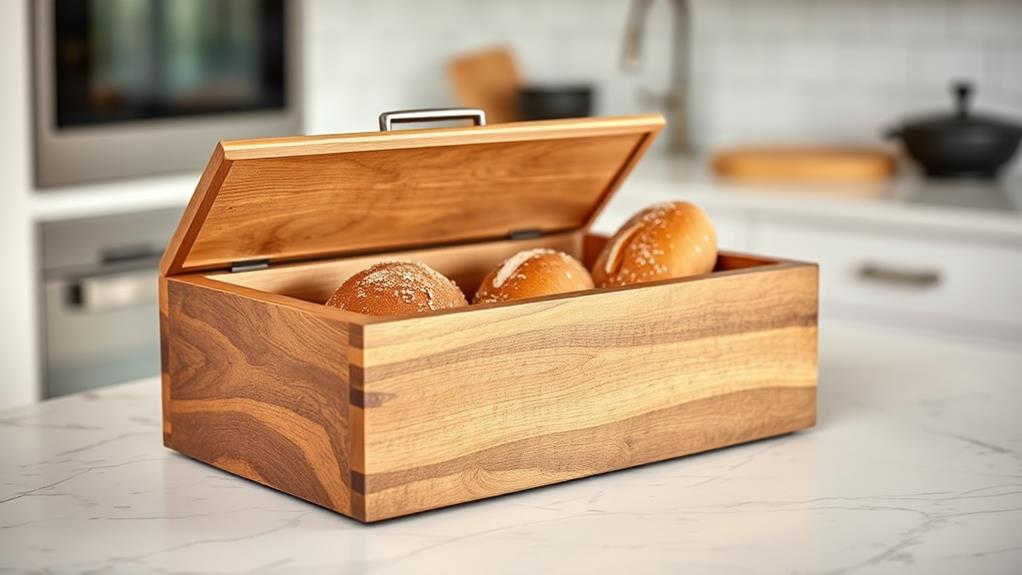
The humble bread box is a marvel of simple engineering. It's designed to create an ideal environment for storing bread, balancing humidity and air circulation to keep your loaves fresh for longer. When you place bread in a bread box, you're creating a microclimate that's perfect for preserving its texture and taste.
Here's how it works: The box traps just enough moisture to prevent your bread from drying out, while still allowing sufficient airflow to inhibit mold growth. This delicate balance is achieved through strategically placed ventilation holes or slats. Unlike plastic bags, which can create a humid environment that accelerates spoilage, bread boxes maintain a stable, room-temperature setting that extends the life of your fresh bread.
Moisture Control and Air Circulation

When you use a bread box, you're taking advantage of a carefully designed system for moisture control and air circulation. The box maintains an ideal humidity balance, trapping just enough moisture to keep your bread fresh while allowing excess humidity to escape through ventilation holes or slats. This delicate balance helps preserve your bread's crust crispness and prevents both drying out and mold growth, ensuring your loaf stays in prime condition for longer.
Humidity Balance Maintenance
Maintaining the perfect humidity balance is a bread box's key function. When storing your bread in a bread box, you're creating an environment that traps just enough moisture to keep your loaf soft while allowing excess humidity to escape. This delicate balance is essential for keeping bread fresh and preventing mold growth.
To understand how a bread box achieves this, consider these four key factors:
- Controlled moisture retention
- Proper air circulation
- Material-specific properties
- Regular maintenance
The bread box's design incorporates ventilation through holes or slats, enabling air circulation while retaining some moisture. This balance helps extend your bread's freshness by 2-3 days compared to plastic storage. Different materials contribute to humidity control in unique ways. Wooden boxes absorb excess moisture, while metal and plastic designs focus on airflow.
To maximize your bread box's effectiveness, open it daily to release accumulated moisture. This simple action helps maintain ideal freshness and prevents mold development. By understanding and utilizing these principles, you'll guarantee your bread stays at its best for longer, making the most of your bread box's humidity-balancing capabilities.
Ventilation System Design
Crafting an effective ventilation system is essential for a bread box's success in preserving bread. You'll find that most bread boxes incorporate ventilation systems designed to maintain ideal humidity levels. These systems typically feature holes, slats, or perforated surfaces that allow for controlled air circulation.
The key to a well-designed bread box is balancing airflow. Too much ventilation can lead to staleness, while too little can cause moisture buildup and mold growth. Many bread boxes use a slotted design to guarantee air circulates around the bread, keeping the crust crispy and the inside moist.
Here's a breakdown of how ventilation affects bread storage:
| Ventilation Level | Humidity Control | Freshness Extension |
|---|---|---|
| Low | Poor | 0-1 days |
| Moderate | Good | 2-3 days |
| High | Excellent | 3-4 days |
| Excessive | Poor | 1-2 days |
Crust Crispness Preservation
Crust crispness preservation is a delicate balancing act in bread box design. The key to keeping your bread fresh and maintaining its crust crispness lies in controlling humidity and airflow. A well-designed bread box keeps the right amount of moisture inside while allowing excess to escape, creating an ideal environment for your loaf.
Here's how a bread box works to preserve crust crispness:
- Traps just enough moisture to prevent rapid drying
- Provides adequate ventilation to prevent sogginess
- Extends the freshness of bread by 2-3 days compared to other storage methods
- Maintains crispy crust for up to four days
The balance of humidity within the bread box is vital. Too much moisture leads to soggy bread, while too little causes rapid drying. Proper ventilation, often achieved through strategically placed holes or slats, allows for necessary air circulation. This airflow is essential in maintaining the right level of humidity and preventing mold growth.
Materials and Design Considerations
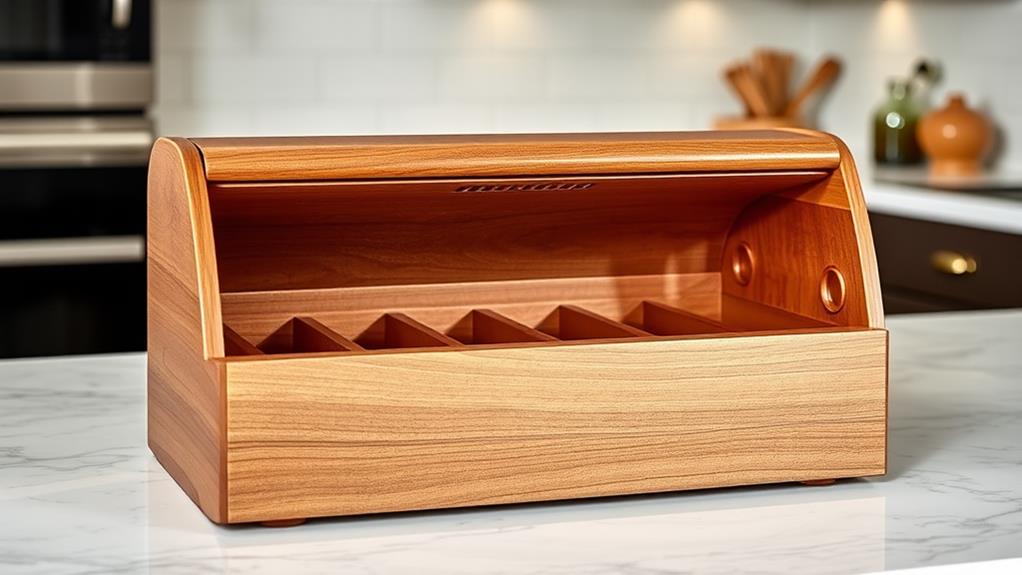
When choosing a bread box, you'll need to evaluate the material it's made from, as this affects how well it regulates moisture and airflow. Wood, metal, and plastic are common options, each with unique properties that influence bread storage conditions. The design of your bread box, including ventilation features and overall dimensions, plays a vital role in maintaining freshness and preventing mold growth.
Material Types and Properties
The heart of a bread box's effectiveness lies in its material composition. When you're choosing a bread box, you'll encounter three main types: wooden bread boxes, metal boxes, and plastic ones. Each material affects moisture retention and humidity differently, which directly impacts how well your bread stays fresh.
Wooden bread boxes are popular for their ability to absorb excess moisture, helping to regulate humidity levels inside the box. Metal boxes, while durable, may cause condensation issues that could lead to mold growth if not properly ventilated. Plastic boxes, though less common, can be effective if designed with proper ventilation holes.
Consider these key factors when selecting a bread box:
- Moisture absorption: Wood naturally absorbs excess moisture
- Ventilation: Look for designs with adequate airflow
- Seal quality: A tighter seal retains moisture but requires better ventilation
- Material durability: Metal and wood tend to last longer than plastic
The material you choose will greatly impact your bread box's performance. Wooden and metal options generally create a more favorable storage environment compared to plastic variants, thanks to their superior moisture regulation properties and ability to maintain consistent humidity levels.
Ventilation and Airflow Features
Airflow is the lifeblood of an effective bread box. When you're storing bread, proper ventilation is essential to maintain its freshness. Bread boxes are designed with specific features, like holes or slats, that allow air to circulate freely. This airflow serves two important purposes: it helps prevent moisture buildup, which can lead to mold growth, and it regulates humidity levels to keep your bread soft without becoming soggy.
The ventilation system in your bread box works by allowing excess moisture to escape while retaining just enough humidity to prevent the bread from drying out. It's a delicate balance that can extend your bread's freshness by 2-3 days compared to other storage methods. However, you'll need to be careful not to overcrowd your bread box, as this can obstruct airflow and create pockets of excess moisture.
Different materials used in bread boxes, such as wood, metal, or plastic, can affect how well they regulate humidity. Wooden boxes, for instance, often excel at maintaining ideal moisture levels. By understanding these ventilation and airflow features, you can make the most of your bread box and enjoy fresher bread for longer.
Size and Shape Variations
From compact countertop models to spacious farmhouse-style containers, bread boxes come in a variety of sizes and shapes to suit different kitchen needs and aesthetics. The size and shape of your bread box can greatly impact its performance regarding storage capacity and air circulation. When choosing a bread box, consider these factors:
- Dimensions: Typically around one foot square, but can vary
- Material: Wood, metal, or plastic, each affecting humidity control
- Ventilation features: Slats or holes for proper air circulation
- Design style: Modern or traditional to complement your kitchen decor
The size of your bread box should accommodate the types and quantities of bread you typically consume. Larger boxes offer more storage space but may require more counter real estate. Shape variations can affect ventilation patterns, with some designs incorporating strategically placed openings to maintain ideal humidity levels. Remember, the right balance of size, shape, and ventilation is essential for preventing mold growth while keeping your bread fresh. Material choices also play a role in humidity control, with wooden boxes naturally regulating moisture levels. By considering these factors, you'll be able to select a bread box that not only fits your kitchen but also effectively preserves your bread.
Benefits of Using Bread Boxes
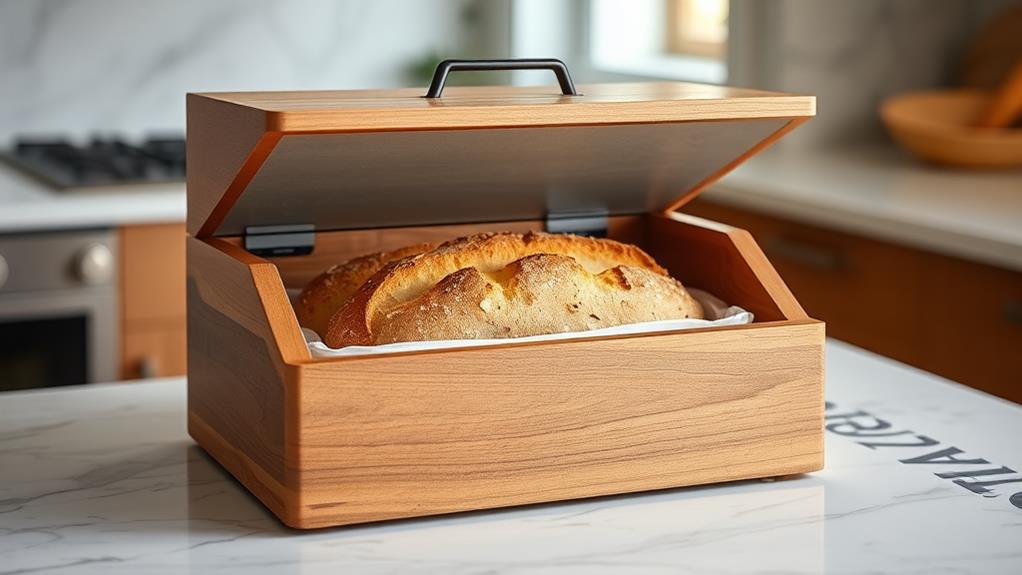
Bread enthusiasts rejoice! Using a bread box to store your bread offers numerous benefits that'll keep your loaves fresher for longer. When you place bread in a bread box, you're creating an ideal environment that helps regulate the humidity and maintain moisture from the bread. This controlled atmosphere can extend the shelf life of your bread by 2-3 days compared to other storage methods.
The bread box's design allows for just enough air circulation to prevent mold growth while trapping the right amount of moisture to keep your bread from drying out. You'll notice that your bread maintains its texture and taste better when stored in a bread box. This balance of humidity levels is essential for preserving the quality of artisanal and homemade loaves.
Another advantage of using a bread box is its eco-friendly nature. By opting for this storage solution, you're reducing your reliance on plastic bags or containers. Additionally, bread boxes provide a pest-resistant environment, protecting your bread from common kitchen intruders like mice and ants. This means you can enjoy fresh, safe bread for longer periods without worrying about unwanted visitors.
Proper Usage and Maintenance
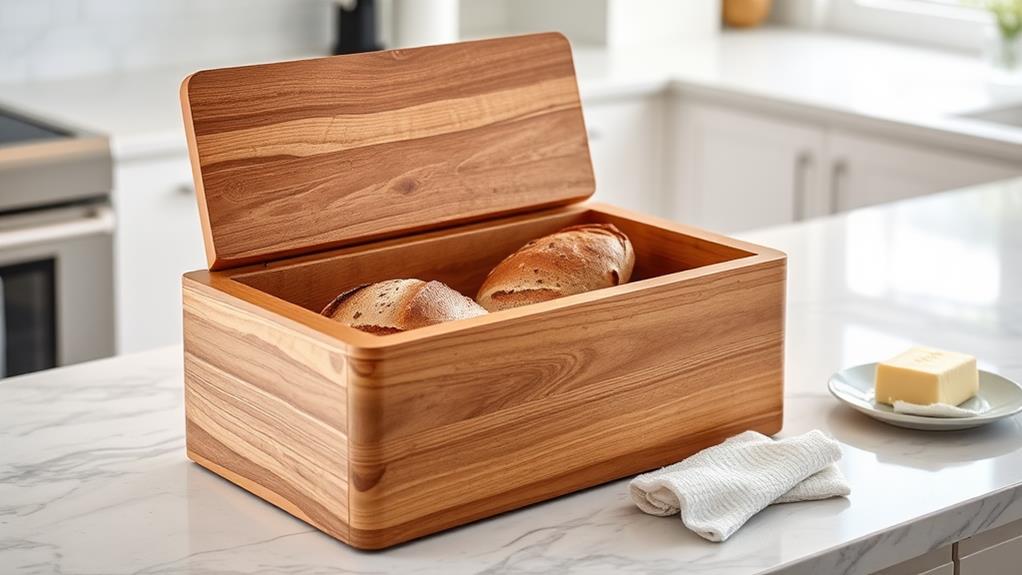
Now that you know the benefits of using a bread box, let's explore how to properly use and maintain one for the best results. Proper usage starts with ensuring ideal air circulation. Always remove plastic packaging from bread before placing it in the box, and make sure the bread has cooled completely to prevent excess moisture. These steps help maintain freshness and reduce the risk of mold growth.
Regular maintenance is essential for keeping your bread box in top condition. Here's a simple routine to follow:
- Remove crumbs frequently to prevent mold and pests
- Clean the interior with a damp sponge regularly
- For wooden boxes, allow quick drying to prevent warping
- Apply mineral oil periodically to wooden boxes for protection
Monitor your stored bread regularly and adjust your practices based on your kitchen's humidity and temperature. If you notice bread becoming stale quickly, you may need to adjust the box's ventilation or your storage method. Remember, proper usage and maintenance of your bread box will greatly extend the freshness of your bread and keep your kitchen organized and hygienic.
Alternatives to Bread Boxes
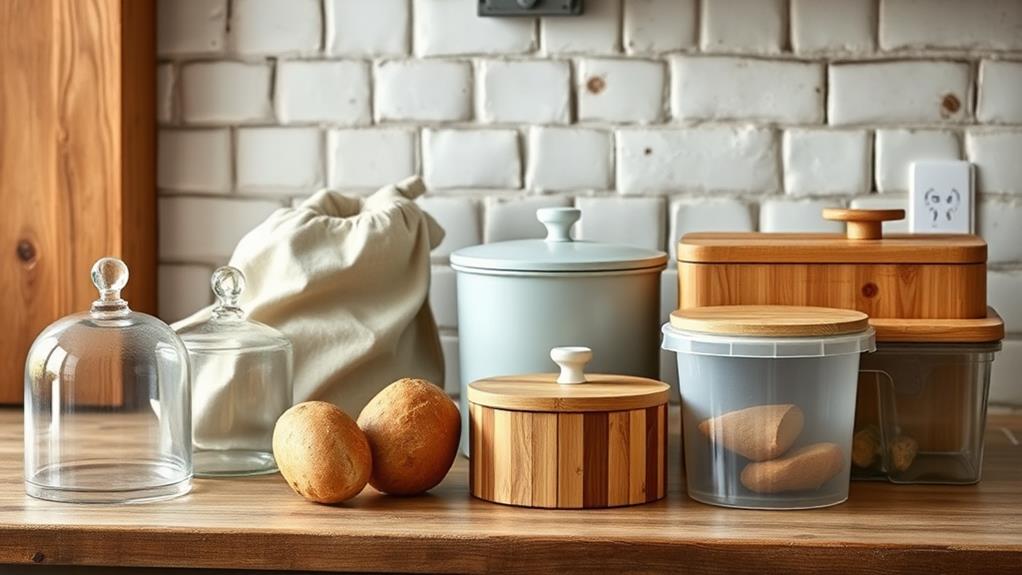
While bread boxes are an excellent way to store bread, they're not the only option available. You might consider using plastic bags or wrap, but be aware that they can lead to a soft crust due to limited air circulation. This method is best for short-term storage of a few days.
Paper bags are another alternative, though they often result in stale bread by the second day. They trap moisture without allowing proper airflow, causing the bread to become hard and difficult to manage. For a more eco-friendly option, silicone bread covers provide a loose seal that allows some air circulation while preventing moisture loss.
Bread storage containers or cloches can help keep your bread fresh and protect it from pests. However, their lack of ventilation may encourage mold growth if not monitored carefully. If you're looking for long-term storage, freezing is an effective method. It can preserve bread for up to a month, but you'll need to wrap it properly to avoid freezer burn.
Each alternative has its pros and cons, so consider your specific needs and bread storage habits when choosing the best method for you.
Frequently Asked Questions
Do Bread Boxes Really Keep Bread Fresh?
Yes, bread boxes really do keep bread fresh. They create an ideal environment by regulating humidity and allowing proper air circulation. You'll find that bread stored in a bread box stays fresh for about 3-6 days, outperforming plastic wrap or bags. The box's ventilation prevents moisture buildup that leads to mold while sealing in enough humidity to maintain texture. Compared to conventional storage methods, you can expect your bread to stay fresh for an extra 2-3 days in a bread box.
What Is the Point of a Bread Box?
You might wonder why you'd need a bread box when plastic bags exist. The point of a bread box is to create an ideal environment for your bread. It regulates humidity and air circulation, keeping your loaves fresh for 3-6 days. You'll find it prevents both drying out and mold growth, thanks to its ventilation features. It's also an eco-friendly storage solution that protects against pests. For artisan and homemade breads, a bread box is particularly effective in maintaining quality.
Do Bread Boxes Keep Bread From Molding?
Yes, bread boxes can help prevent mold on your bread. They work by creating an environment that balances humidity and airflow. You'll find that the ventilation in a bread box allows excess moisture to escape, reducing the conditions where mold thrives. Unlike sealed plastic bags, which trap moisture, bread boxes promote air circulation. This controlled environment can keep your bread fresh for up to 3-6 days, greatly decreasing the chances of mold compared to other storage methods.
How Does a Bread Proofing Box Work?
While a bread box keeps your loaf fresh, a bread proofing box nurtures your dough. You'll find it's a controlled environment that optimizes yeast activity. It maintains a warm, humid atmosphere, typically 75-85°F (24-29°C), using built-in heaters and water reservoirs. You can adjust temperature and humidity settings for different doughs. The enclosed space shields your dough from drafts and temperature fluctuations. By using a proofing box, you'll reduce rising time and achieve more consistent results in your bread baking.





